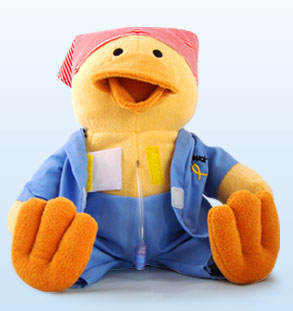Learning your child has cancer or another serious illness that is or could be life-threatening has the power to make you feel very alone, but it also introduces you to a network of people who understand what you’re going through and understand the power of hope and compassion.
That was the story of Lu Sipos, her husband Rob, and their son, Gabe. Gabe is the inspiration behind Gabe’s Chemo Duck Program®. Chemo Ducks are one of Standish’s favorite and most-used medical play therapy tools. Chemo Ducks are a huggable educational tool that help kids understand what’s going on with their bodies and treatment in a fun, non-threatening way.
Founder, Lu Sipos graciously took time to talk to us about the story behind this amazing program and what they’re doing to keep the program relevant and useful.

How did the Chemo Duck Program get started?
It was named for our son, Gabe who was diagnosed just before turning one with vity.
My husband and I felt very lost and had a hard time understanding what our role was and how life would go on. But life did go on and we found ourselves in the world of childhood cancer treatment.
One day, before a treatment, we needed some fun and a bit of respite. I took a toy duck that had been a gift and dressed it with surgical clothes and took it to the hospital. It ended up being very powerful. Doctors and nurses began incorporating the duck into their explanations. Gabe was transformed, and finally got some autonomy and understanding of what was happening to him.
Our friends in the Chemo ward started asking for their own ducks. I made as many as I could, but we realized we needed a foundation to help us meet the need. So, we formed one. Since then, the growth has always been so organic—we’re simply meeting a need.
What’s life like now, 12 years after Gabe’s diagnosis and the creation of the Chemo Duck?
We’re trying to keep up with technology and meet kids where they live—that means through apps and online activities. We’re trying to translate our activities to app format so that while children wait in clinics they have something to entertain them and learn from.
Gabe himself now has a huge role. He is working with a developer to help us with this task. Gabe is fantastically healthy—but suffers from the radiation.
What’s most missing from today’s care model for seriously ill children?<br />
It’s hard to say because our experience was 12 years ago, but I’d say that now, since everything is so automated, it’s personal interaction. Interaction is missing due to HIPPA, and now everybody goes off in their own room and nobody sees anybody. One of the most amazing parts of Gabe’s treatment was the community we developed with other parents and children. That’s gone now.
Outside of the U.S., I know there is a great need for play therapy tools. It breaks my heart that there are so many children starving for this help that is so simple to provide.
